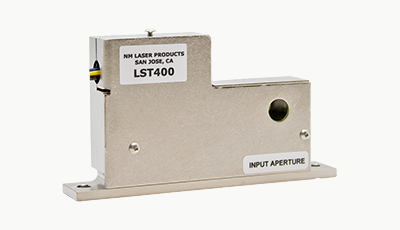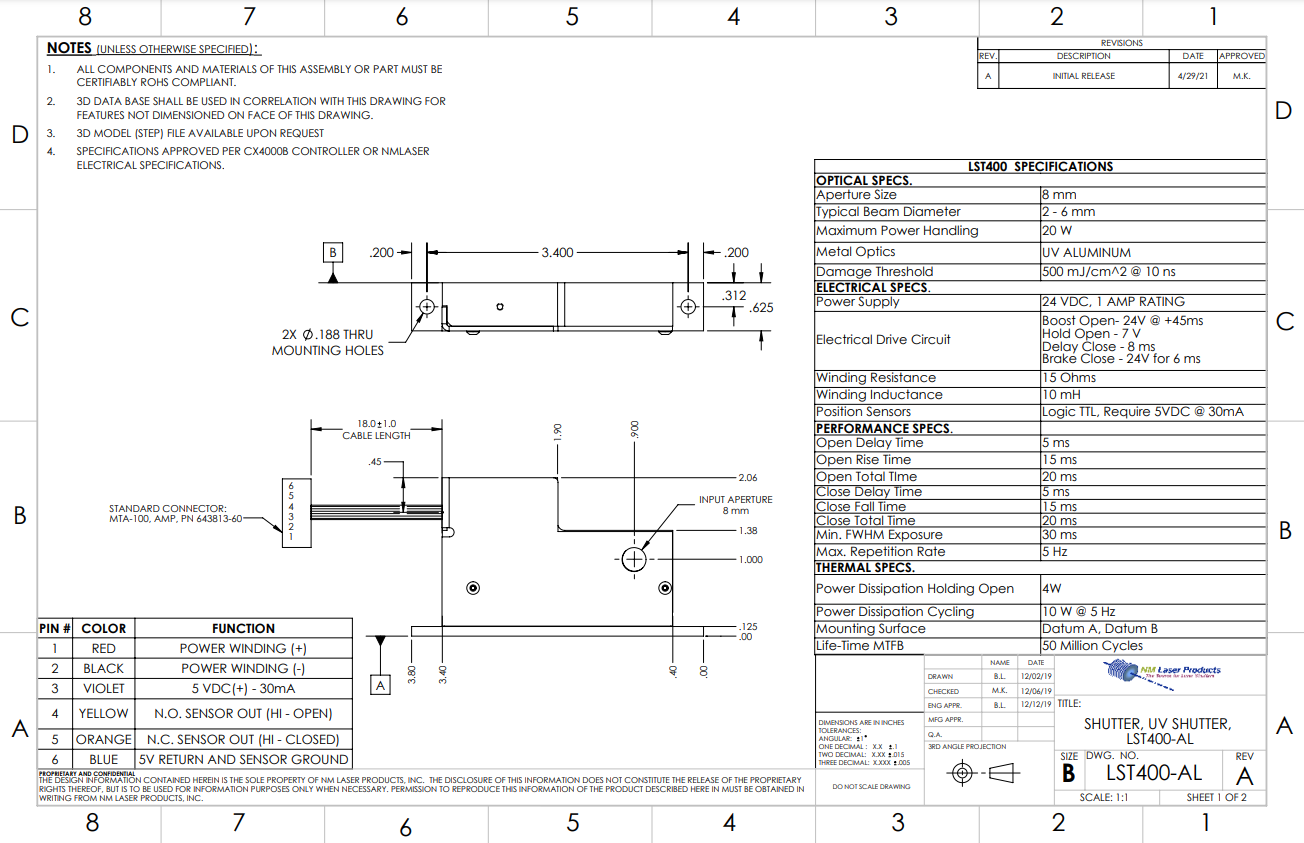
LST400-AL
Features
Optical Power Handling: 20 W
Aperture: 8 mm
Switching Speed: 20 ms
Logic Position Sensors
Optics: Aluminum
Optical Power Handling: 20 W
Aperture: 8 mm
Switching Speed: 20 ms
Logic Position Sensors
Optics: Aluminum
$695.00
Applications
Safety Interlock
Processing
Diverging Beams
Tight Zones
OEM Integration Top Loader
Safety Interlock
Processing
Diverging Beams
Tight Zones
OEM Integration Top Loader
Optical Specifications
| Aperture Diameter | 8.0 mm |
| Typical Beam Diameter | 2.0 to 6.0 mm |
| Max. Optical Power Handling | 20 W |
| Optics | Aluminum |
| Damage Threshold | 500 mJ/cm2 at 10 ns |
Performance Specifications
| Open Delay Time | 5 ms |
| Open Rise Time | 15 ms |
| Open Total Time | 20 ms |
| Close Delay Time | 5 ms |
| Close Fall Time | 15 ms |
| Close Total Time | 20 ms |
| Min. FWHM Exposure | 30 ms |
| Max. Shutter Repetition Rate | 5 Hz |
| Lifetime | 50 Million Cycles |
Thermal Specifications
| Thermal Power Dissipation Holding Open | 4 W |
| Thermal Power Dissipation Cycling | 10 W at 5 Hz |
| Mounting Surface for Thermal Sinking | Datum A, Datum B |
Custom Options
| Wire Length | Any Length |
| Wire/Cable Type | Teflon or Vinyl |
| Connector | Any 6-pin Connector |
| Identification | Engraving, Labels |
Electrical Specifications
| Power Supply | 24 VDC, 1 Amp Rating |
| Electrical Drive Circuit | Boost Open = 24 V at +45 ms Hold Open = 7 V Delay Close = 8 ms Brake Close = 24 V for 6 ms |
| Recommended Controller | CX4000B |
| Winding Resistance | 15 ohms Nominal |
| Winding Inductance | 10 mH |
| Position Sensors | Logic TTL, Require 5 VDC @ 30 mA |
| Cable/Wire Type, No., Length, Termination | 22 g, six wires, 18 in., MTA-100, AMP, P/N 643813-60 |
| User Drive Circuit/Cap Discharge | 24 V, C=4700 mmF, R=50 ohm, use Flyback Diode 1N4001 |
| User Drive Circuit/PWM Type | 24 V for 50 ms, then drop to 7 V hold, use Flyback Diode 1N4001 |
Read sensor outputs with reference to the blue ground wire. These outputs are totem-pole buffered TTL, seeking a load of ~10 K ohms. Typical output is 4.5 V. Do not try to draw more than about 5 mA from the Yellow or Orange outputs, or the voltage will load down.
Wire Pin # - Color
| 1 – Red | Power Winding (+) |
| 2 – Black | Power Winding (-) |
| 3 – Violet | Sensor Supply, 5 VDC(+) – 30 mA |
| 4 – Yellow | Normally Open Sensor (HI – Open) |
| 5 – Orange | Normally Closed Sensor (HI – Close) |
| 6 – Blue | 5V Return and Sensor Ground |
Attributes
| Dimensions | 3.80 in. x 2.06 in. x 0.64 in. |
| Weight | ~4 oz. |
| Classification | Safety/Process |
| Gravity Considerations | Symmetric Open/Close speed with base down. More power used for upside-down mounting |
| Specifications Date | April 27, 2021 |
